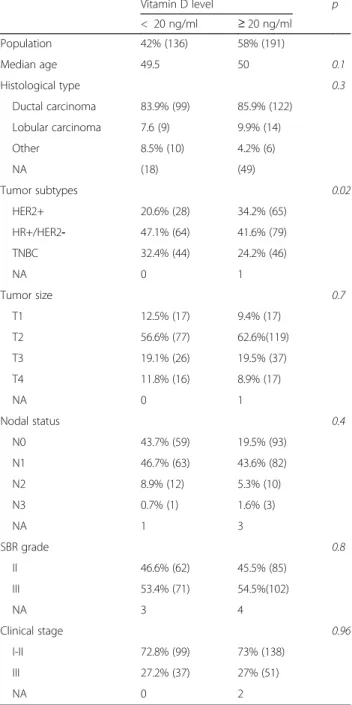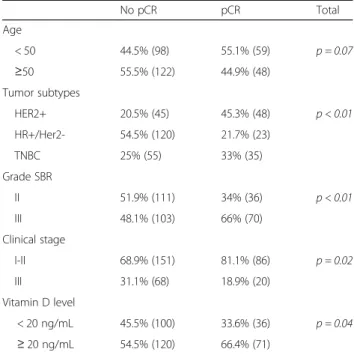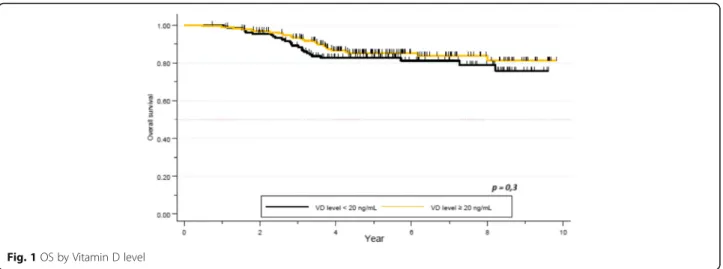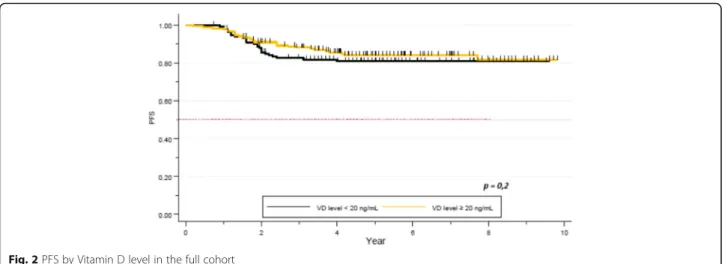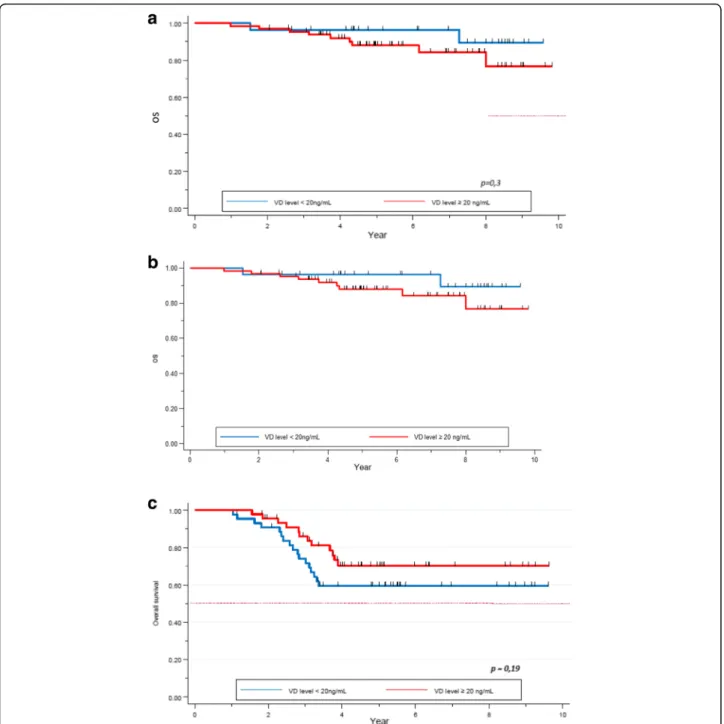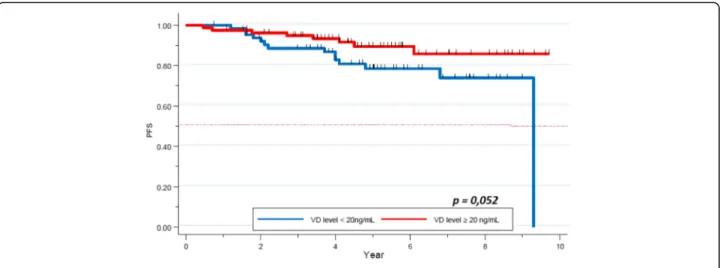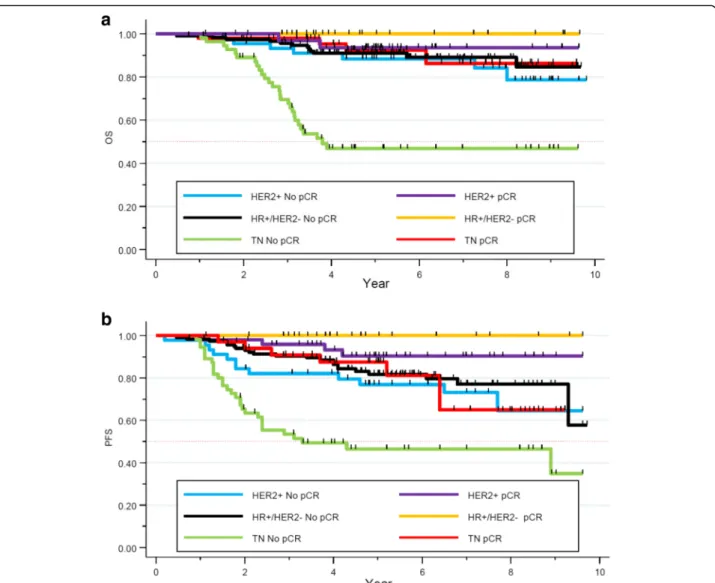HAL Id: hal-02292914
https://hal.umontpellier.fr/hal-02292914
Submitted on 20 Sep 2019
HAL is a multi-disciplinary open access
archive for the deposit and dissemination of
sci-entific research documents, whether they are
pub-lished or not. The documents may come from
teaching and research institutions in France or
abroad, or from public or private research centers.
L’archive ouverte pluridisciplinaire HAL, est
destinée au dépôt et à la diffusion de documents
scientifiques de niveau recherche, publiés ou non,
émanant des établissements d’enseignement et de
recherche français ou étrangers, des laboratoires
publics ou privés.
breast cancer: a retrospective study
Marie Viala, Akiko Chiba, Simon Thèzenas, Laure Delmond, Pierre-Jean
Lamy, Sarah Mott, Mary Schroeder, Alexandra Thomas, William Jacot
To cite this version:
Marie Viala, Akiko Chiba, Simon Thèzenas, Laure Delmond, Pierre-Jean Lamy, et al.. Impact of
vita-min D on pathological complete response and survival following neoadjuvant chemotherapy for breast
cancer: a retrospective study. BMC Cancer, BioMed Central, 2018, 18 (1), pp.770.
�10.1186/s12885-018-4686-x�. �hal-02292914�
R E S E A R C H A R T I C L E
Open Access
Impact of vitamin D on pathological
complete response and survival following
neoadjuvant chemotherapy for breast
cancer: a retrospective study
Marie Viala
1*, Akiko Chiba
2, Simon Thezenas
3, Laure Delmond
4, Pierre-Jean Lamy
5, Sarah L. Mott
6,
Mary C. Schroeder
7, Alexandra Thomas
8and William Jacot
1Abstract
Background: There has been interest in the potential benefit of vitamin D (VD) to improve breast cancer outcomes. Pre-clinical studies suggest VD enhances chemotherapy-induced cell death. Vitamin D deficiency was associated with not attaining a pathologic complete response (pCR) following neoadjuvant chemotherapy (NAC) for operable breast cancer. We report the impact of VD on pCR and survival in an expanded cohort.
Methods: Patients from Iowa and Montpellier registries who had serum VD level measured before or during NAC were included. Vitamin D deficiency was defined as < 20 ng/mL. Pathological complete response was defined as no residual invasive disease in the breast and lymph nodes. Survival was defined from the date of diagnosis to the date of relapse (PFS) or date of death (OS).
Results: The study included 327 women. Vitamin D deficiency was associated with the odds of not attaining pCR (p = 0.04). Fifty-four patients relapsed and 52 patients died. In multivariate analysis, stage III disease, triple-negative (TN) subtype and the inability to achieve pCR were independently associated with inferior survival. Vitamin D deficiency was not significantly associated with survival in the overall sample; however a trend was seen in the TN (5-years PFS 60.4% vs. 72.3%,p = 0.3), and in the hormone receptor positive /human epidermal growth factor receptor 2 negative (HER2-) subgroups (5-years PFS 89% vs 78%,p = 0.056).
Conclusion: Vitamin D deficiency is associated with the inability to reach pCR in breast cancer patients undergoing NAC. Keywords: Vitamin D, Neo-adjuvant breast cancer, pCR
Background
Neoadjuvant chemotherapy (NAC) has become a stand-ard of care in locally advanced breast cancer, especially for patients with large tumor size, lymph node metasta-sis, HER2 overexpression, triple negative breast cancer (TNBC) subtype, or inflammatory breast cancer. The aims of NAC are to reduce the size of the tumor to in-crease the breast conservation rate and to initiate an early systemic therapy especially in locally advanced
breast cancer (LABC) to treat micrometastatic disease. This therapeutic approach allows an in vivo assessment of the tumor chemotherapy (CT) sensitivity using the pathological response data [1]. Systemic treatment usu-ally consists of sequential chemotherapy regiment with anthracycline and taxanes, with the addition of trastuzu-mab for patients with HER2 amplified (HER2+) tumors. A relationship between chemotherapy response and sur-vival has been suggested in some trials and confirmed in two large meta-analyses [2, 3]. Indeed, pCR is associated with improved overall survival (OS). This association ap-pears stronger in the HER2+/ HR- disease with a pCR rate of approximately 40% [4]. Response after NAC in those patients is a strong predictor of recurrence and
* Correspondence:marie.viala@icm.unicancer.fr
1Department of Medical Oncology, Institut Régional Du Cancer de
Montpellier ICM, 208 Avenue des Apothicaires, Cedex-5 34298 Montpellier, France
Full list of author information is available at the end of the article
© The Author(s). 2018 Open Access This article is distributed under the terms of the Creative Commons Attribution 4.0 International License (http://creativecommons.org/licenses/by/4.0/), which permits unrestricted use, distribution, and reproduction in any medium, provided you give appropriate credit to the original author(s) and the source, provide a link to the Creative Commons license, and indicate if changes were made. The Creative Commons Public Domain Dedication waiver (http://creativecommons.org/publicdomain/zero/1.0/) applies to the data made available in this article, unless otherwise stated.
survival. Triple negative breast cancer patients represent a subgroup benefitting from NAC, with pCR rate of 20 to 40% [5–8]. In this subset of patients, obtaining pCR is a biomarker of improved survival. On the contrary, not attaining pCR is associated with a poor prognosis, [7].
Vitamin D (VD) has gained in interest in recent years due to its impact on cancer.
Indeed, VD seems to play a key role in the cycle cell pathway, especially in breast cancer. Preclinical data have found that VD impacts the regulation of cancer cell proliferation by intervening on the cell cycle via kinases such as cyclines, cyclin-dependant kinases and CDK physiological modulators [9]. In addition VD has an anti-proliferative effect and an anti-oxidative stress, anti-invasion and anti-angiogenesis activities [10]. Vitamin D might also have a synergistic effect on the anti-tumoral activity of some anti-neoplastic agents, such as anthracyclines, and taxanes [11]. This effect ap-pears optimal when VD is administrated before or dur-ing chemotherapy [12]. Nevertheless, it has been proven that VD deficiency is extremely frequent in the global population, and even more prevalent in breast cancer patients [13].
In a previous trial, we confirmed those data, and showed that this deficit increases during NAC [14]. In addition, a VD supplementation during NAC appears safe and feasible [15]. Further, in a previous retrospective multicenter study, we demonstrated a statistically signifi-cant correlation between VD level at baseline and pCR in patients with LABC receiving NAC [16]. The object-ive of our present study was to confirm these results in a larger population by evaluating in an expanded cohort the impact of VD level on pCR following breast cancer NAC and to further analyze the association between VD level in this setting and survival.
Methods
Design and patients
We performed an observational, retrospective study in-cluding 327 patients treated with NAC in our Compre-hensive Cancer Center in Montpellier between 2005 and 2010, and at the University of Iowa Holden Comprehen-sive Cancer Center between 2009 and 2015. One hun-dred and forty four patients were already included in a previous study published by Chiba et al. [16], we in-cluded 183 additional patients in this study. The deci-sion for NAC was validated in multidisciplinary boards based on the local standard of care. Patients received se-quential anthracycline and/or taxane-based chemother-apy, with the adjunction of HER2-directed therapies for HER2+ tumors (6 to 8 cycles). After completion of NAC, patients underwent breast surgery. Patients har-boring HR+ tumors received the recommendation for adjuvant hormonal therapy after curative surgery and
patients with HER2+ tumors received the recommenda-tion for adjuvant trastuzumab per standard of care guide-lines. Pathological response determination was made by institutional pathologists. Pathological complete response was defined as no residual invasive disease in breast and lymph nodes. Survival was defined as the date of diagnosis to the date of relapse (progression-free-survival [PFS]) or date of death (overall survival [OS]). This study was ap-proved by the local institutional review boards.
Selection criteria
Women treated with NAC with available (frozen) serum for VD level determination before or from the start of their CT were included. We excluded patients with metastatic disease at diagnosis, patients without an avail-able VD serum, patients with a personal history of an-other cancer, or with bilateral breast cancer.
Vitamin D analysis
Vitamin D deficiency was defined as < 20 ng/mL. Serum samples were collected at baseline of chemotherapy or at cycle 2. At Iowa samples of plasma were tested for 25, hydroxyl vitamin D using electrochemiluminescence im-munoassay and multiplex flow imim-munoassay methodolo-gies. In Montpellier, they were tested using the DiaSorin 25-Hydroxyvitamin D-125I RIA kit.
Clinical staging and pathology
Clinical breast cancer staging was determined using the 7th edition of the American Joint Committee on Cancer (AJCC) at both institutions. At Iowa, institutional prac-tices were to confirm lymph node involvement by biopsy of any radiographically or clinically suspicious axillary lymph nodes. In the French cohort, axillary ultrasound was not routinely performed. All breast cancer was diag-nosed by biopsy. Immunohistochemistry (IHC) was used to determine estrogen receptor (ER), progesterone recep-tor (PR) status. For this analysis hormone receprecep-tor positiv-ity (HR+) was defined as≥10% expression of ER or PR on the tumor. HER2 testing was performed as per ASCO/ CAP guidelines [17]. For equivocal HER2 results (2+) on IHC in situ hybridization was performed. Tumors which were HR- and HER2- were considered TNBC.
Statistical considerations
Qualitative variables were expressed in percentage with contingency table and were compared using a Chi-2 (or Fisher’s exact test if applicable). Quantitative variables were expressed with the median and range, and were compared using the Kruskal Wallis test. The pCR was evaluated based on Sataloff and Chevalier classifications [18]. Overall survival was measured between the date of the diagnosis and the date of death, or the date of the last news. Progression free survival rate was estimated
using a reverse Kaplan-Meier method and presented with its 95% CI. Log rank test was used to compare the differ-ence between the groups. The median follow-up was esti-mated using a reverse Kaplan-Meier method. Multivariate analysis with logistic regression on pCR was performed to evaluate the correlation between the different parameters. Allp-values were two-sided (significance level 5%). Statis-tical analyses were performed using the STATA 13 soft-ware (Stata Corporation, College Station, TX).
Results
Patients
All patients who met the inclusion criteria described in the Methods were included. A total of 327 patients were enrolled in our observational, retrospective, multicenter study. Median age was 50 years old. Forty-two percent of our cohort had a VD level below 20 ng/ml (Table1). There was no difference on the VD levels depending on time of measurement (baseline or cycle 2, p = 0.18). Eighty-five percent of tumors (n = 221) were ductal carcinomas, 8.8% lobular carcinomas (n = 23), and 6.2% (n = 16) was from another histological subgroup. Pathological grade (using the Ellis and Elston-modified SBR) II and III were recorded in 45.9% (n = 147) and 54.1% (n = 173) respectively. At diagnosis, 9.5% of patients presented with cT1 (n = 31), 60.1% with cT2 (n = 196), 19.3% with cT3 (n = 63), and 10.1% with cT4 (n = 33). There was a clinical lymph node involvement (cN≥ 1) in 52.9% of the patients (n = 171). Seventy three percent (n = 237) of patients were diagnosed with clinical stage I or II, and 27% (n = 88) were clinical stage III. In our co-hort, 28.5% (n = 93) of tumors had HER2+ status (14.7% [n = 48] were HR-/HER2+ and 13.8% [n = 45] were HR +/HER2+), 43.9% (n = 143) were HR+/HER2-, and 27.6% (n = 90) were TNBC.
Low VD level, as compared with VD sufficient level was associated significantly with HR+/HER2- (47.1% vs 41.6%) and TN disease status (32.4% vs 24.2%) (p = 0.02). Vitamin D level did not differ between the HR+/HER2+ and HR-/ HER2+ subgroups. Only tumor subtype was significantly different by VD status at the 5% level (Table1).
Pathological complete response and vitamin D levels
Pathological complete response was obtained in 32.7% (n = 107) of the patients in our cohort. Using a logis-tic regression model, pCR and VD level were statisti-cally and significantly associated (p = 0.04). Vitamin D deficiency was associated with the chance of not obtaining pCR (73.5% non pCR vs 26.5% pCR in the low VD group). Moreover, patients with a sufficient VD level achieved pCR in 37.2% of cases.
Pathological complete response was significantly as-sociated with some tumors subtypes (p < 0.01): 45.3% of patients with HER2+ tumors achieved a pCR
(62.5% in the HR-/HER2+ and 40% in the HR+/HER2 + subgroups, Additional file 1), 33% for TNBC tu-mors, and 21.7% in the HR+/HER2- subtype. In the HR+/HER2+ subgroups (n = 45/327), VD level was not statistically associated with pCR (p = 0.08) Add-itional file 2. Histopathologic grade III tumors repre-sented 66% of pCR cases compared with 34% for the grade II (p = 0.03) (Table 2). Patients with low clinical stage (I or II) achieved pCR significantly more often than those affected by higher stage disease (36.3% vs 22.7%; p = 0.02).
Table 1 Patient and Tumor Characteristics by Vitamin D level
Vitamin D level p < 20 ng/ml ≥ 20 ng/ml Population 42% (136) 58% (191) Median age 49.5 50 0.1 Histological type 0.3 Ductal carcinoma 83.9% (99) 85.9% (122) Lobular carcinoma 7.6 (9) 9.9% (14) Other 8.5% (10) 4.2% (6) NA (18) (49) Tumor subtypes 0.02 HER2+ 20.6% (28) 34.2% (65) HR+/HER2- 47.1% (64) 41.6% (79) TNBC 32.4% (44) 24.2% (46) NA 0 1 Tumor size 0.7 T1 12.5% (17) 9.4% (17) T2 56.6% (77) 62.6%(119) T3 19.1% (26) 19.5% (37) T4 11.8% (16) 8.9% (17) NA 0 1 Nodal status 0.4 N0 43.7% (59) 19.5% (93) N1 46.7% (63) 43.6% (82) N2 8.9% (12) 5.3% (10) N3 0.7% (1) 1.6% (3) NA 1 3 SBR grade 0.8 II 46.6% (62) 45.5% (85) III 53.4% (71) 54.5%(102) NA 3 4 Clinical stage 0.96 I-II 72.8% (99) 73% (138) III 27.2% (37) 27% (51) NA 0 2
In a multivariate analysis, pCR was significantly associ-ated with age, clinical stage, VD level, and the HER2+ subtype (Table3).
Survival
After a median follow-up of 5.3 years, 54 patients re-lapsed and 52 patients died. Median OS was not reached. Death rate was 15.9%. One- and 5 year-OS was
100 and 83% respectively in the VD deficient group, and 99 and 85% respectively in the VD sufficient group. No difference was seen in terms of survival between these two subgroups (p = 0.3, Fig. 1). Five year-OS was 89% in patients with clinical stage I or II, compared to 72% for stage III. The difference was statistically sig-nificant (p < 0.01). There was a sigsig-nificant correlation between survival and pCR. Five year-OS for patients not obtaining pCR was 79% (95% CI 0.73–0.84), com-pared to 94% (95% CI 0.87–0.98) for those who ob-tained pCR (p = 0.0007). Ninety-one percent (95% CI 0.82–0.95) of patients with HER2+ tumors were alive at 5 years, while 92% (95% CI 0.86–0.96) for the HR +/HER2- subgroup, and 65% (95% CI 0.53–0.74) in the TNBC group. The tumor subtypes constitute an inde-pendent and significant factor for survival (p = 0.00001, Table4).
In a multivariate analysis, clinical stage (p = 0.001), TN subgroup (p = 0.0001) and pCR (p = 0.001) were the only variables statistically correlated with OS (Table5).
After a median follow up of 5.3 years, median PFS was not reached. Five year-PFS was 78% (95% CI 0.73–0.83) in our global cohort. Five year-PFS rate was 76% in the VD deficient subgroup, whereas 80% in the VD sufficient group. The difference did not achieve statistical signifi-cance (p = 0.2, Fig.2). Clinical stage (84% 5-year-PFS for stages I-II and 62% for stage III) (p = 0.00001), TNBC subtype (62% 5-years-PFS,p = 0.00001), and pathological response (72% 5- year-PFS for patients not achieving pCR, versus 92% for the pCR group, p = 0.0002) were significantly correlated with PFS. Other factors as histo-pathologic grade (p = 0.3), and age (p = 0.1) did not ap-pear as significant factors correlated with pCR (Table6).
In a multivariate analysis, clinical stage (p = 0.001), TNBC subtype (p < 0.01) and pCR (p < 0.01) were the only variables significantly associated with PFS (Table7).
Vitamin D and survival by tumor subtypes
Regarding OS, we found no statistical difference in the 5-year survival rate for patients with HER2+ (p = 0.3) and HR+/HER2- (p = 0.8) tumors, depending on their VD level at diagnosis (Fig. 3a, b). Regarding the TNBC subgroup, 5-year-OS was 59% (95% CI 0.4–0.7) in the VD deficient group versus 70% (95% CI 0.5–0.8) in the VD sufficient group. This trend was not statistically sig-nificant (p = 0.2, Fig.3c).
We analyzed PFS depending on VD level and tumor subtypes. The 5-year-PFS was of 92 and 79% in the VD deficient and the VD sufficient group respectively for pa-tients with HER2+ tumors (p = 0.20). Regarding the HR +/HER2- cohort, 5-year-PFS rates were 78 and 89% re-spectively, this difference was approached statistical sig-nificance (p = 0.056), Fig. 4). Finally, a non-statistically
Table 2 Correlation between pCR and clinical-pathological data: univariate analysis No pCR pCR Total Age < 50 44.5% (98) 55.1% (59) p = 0.07 ≥50 55.5% (122) 44.9% (48) Tumor subtypes HER2+ 20.5% (45) 45.3% (48) p < 0.01 HR+/Her2- 54.5% (120) 21.7% (23) TNBC 25% (55) 33% (35) Grade SBR II 51.9% (111) 34% (36) p < 0.01 III 48.1% (103) 66% (70) Clinical stage I-II 68.9% (151) 81.1% (86) p = 0.02 III 31.1% (68) 18.9% (20) Vitamin D level < 20 ng/mL 45.5% (100) 33.6% (36) p = 0.04 ≥ 20 ng/mL 54.5% (120) 66.4% (71)
Table 3 Correlation between pCR and clinical-pathological data: multivariate analysis pCR OR 95% CI p Age < 50 ≥ 50 0.45 0.3–0.7 0.001 Clinical stage I-II III 0.34 0.2–0.6 0.0001 Histological grade (SBR) II III 1.19 0.7–1.9 0.5 Tumor subtypes HER2+ 1.6 0.7–3.8 0.2 HR+/Her2-TNBC 1.0 0.5–2.3 0.9 VD level < 20 ng/mL ≥ 20 ng/mL 0.43 0.2–0.8 0.01
significant trend was observed in the TNBC subgroup (60.4% vs 72.3% respectively,p = 0.3, Fig.5).
Survival and pCR depending on the profile subgroup
We evaluated the 5-year-OS of our cohort depending on the NAC response and their tumor subtypes. No signifi-cant difference in terms of OS was seen in the HER2+ and HR+/HER2- subgroup. Nevertheless, in the TNBC subgroup, the 5-year-OS was statistically significant (93% for patients obtaining pCR, versus 47% for non-pCR cases, p < 0.0001). Neoadjuvant chemotherapy
response appeared as a strong and independent prognos-tic factor of survival in the TNBC subgroup (Fig.6a).
Regarding PFS, 5-year-PFS rate was 77% versus 90% in the non pCR and pCR group respectively in the HER2+ subgroup (p = 0.03). In the HR+/HER2- co-hort, 5-year-PFS rate was of 81% versus 100% in the non pCR and pCR group respectively (p = 0.03). Finally, in the TNBC subtype, 5-years-PFS rate for women not achieving a pCR was 46% while it was 87%
Fig. 1 OS by Vitamin D level
Table 4 Correlation between OS and clinical-pathological data in a univariate analysis 5 years-OS (%) 95%CI p Age 0.2 < 50 86 0.79–0.91 ≥ 50 82 0.76–0.88 VD level 0.3 < 20 ng/mL 82% 0.75–0.88 ≥ 20 ng/mL 85% 0.79–0.9 Clinical stage 0.00001 I-II 89% 0.84–0.93 III 72% 0.61–0.80 pCR 0.0007 no 79% 0.73–0.84 yes 94% 0.86–0.98 Tumor subtypes 0.00001 HER2+ 90% 0.82–0.95 HR+/Her2- 92% 0.86–0.96 TNBC 65% 0.53–0.74 SBR grade 0.4 II 86% 0.79–0.91 III 83% 0.76–0.88
Table 5 Correlation between OS and clinical-pathological data in a multivariate analysis HR 95%CI p Age (years) Range (26–74) Median: 49.5 < 50 ≥ 50 1.2 0.7–2.3 0.5 VD level < 20 ng/mL ≥ 20 ng/mL 1.03 0.6–1.8 0.9 Clinical stage I-II III 2.8 1.6–5.0 0.001 Tumor subtypes HER2+ 1.77 0.8–4.1 0.1 HR+/HER2-TNBC 6.5 3.1–13.7 0.0001 pCR no yes 0.2 0.09–0.5 0.001 SBR grade II III 0.86 0.5–1.6 0.6
for those achieving pCR (p = 0.0009, Fig. 6b). Patho-logical complete response appears as a strong and in-dependent prognostic factor of survival, especially in the TNBC subgroup.
Discussion
We performed a retrospective, observational, multicen-ter study which included 327 breast cancer patients treated by NAC. We evaluated specifically their VD level at the beginning of NAC and its impact on pCR and
survival. Notably, we did not have post-NAC serial eval-uations of VD levels during the 5-years follow-up.
Breast cancer patients are more frequently affected by a VD deficiency than the general population. Seventy to 80% of these patients have VD level below the lower limit of normal at breast cancer diagnosis, and that pro-portion even increases during NAC [13, 14, 19]. Our study confirms that patients treated by NAC frequently have deficient VD level. In fact, almost half of our co-hort (42%) had baseline VD level below 20 ng/mL. Our population appears less deficient than that reported in
Fig. 2 PFS by Vitamin D level in the full cohort
Table 6 Correlation between PFS and clinical-pathological data in a univariate analysis 5 years-PFS (%) 95%CI p Age 0.1 < 50 82 0.75–0.88 ≥ 50 75 0.67–0.81 VD level 0.2 < 20 ng/mL 76 0.67–0.82 ≥ 20 ng/mL 80 0.73–0.85 Clinical stage 0.00001 I-II 84 0.78–0.89 III 62 0.51–0.72 pCR 0.0002 no 72 0.65–0.78 yes 92 0.84–0.96 Tumor subtypes 0.00001 HER2+ 84 0.74–0.90 HR+/HER2- 84 0.77–0.90 TNBC 62 0.51–0.72 SBR grade 0.3 II 79 0.71–0.85 III 78 0.71–0.84
Table 7 Correlation between PFS and clinical-pathological data in a multivariate analysis HR 95%CI p Age < 50 ≥ 50 1.4 0.84–2.3 0.2 VD level < 20 ng/mL ≥ 20 ng/mL 0.9 0.6–1.5 0.8 Clinical stage I-II III 2.4 1.4–3.9 0.001 Tumor subtypes HER2+ 1.6 0.30–1.21 0.2 HR+/HER2-TNBC 4.3 1.42–4.80 0.002 pCR no yes 0.25 0.12–0.50 0.0001 SBR grade II III 0.94 0.52–1.70 0.8
other series (74–80% VD deficiency rate) [14,19], how-ever the deficiency rate is highly dependent of geo-graphic and lifestyle variables [20]. The TNBC subtype appears to be the most affected subgroup. This result is consistent with the report published by Yao et al. [21]. Considering the VD implication in the tumorigenesis process (proliferation, apoptosis, and angiogenesis), it could be hypothesized that this deficiency might have a clinical impact on tumor response to treatment.
Few studies have evaluated the association between VD and pCR. Most of these studies did not show a significant correlation between these two factors. In the NEOZOTAC trial, a large proportion of patients were affected with low VD level at diagnosis, and even lower VD levels at the end of NAC. No correlation was seen between VD level and pCR, nevertheless, patients with sufficient VD level had a better pathological response than the others, even if this re-sult did not achieved statistical significance [22]. Clark et al.
Fig. 3 a OS depending on the Vitamin D level in the HER2+ tumor subtype. b OS depending on Vitamin D level in the HR+/HER2- tumors subtypes. c OS depending on the Vitamin D level in the TN tumor subtypes
studied, in a smaller trial, the relationship between VD and chemotherapy response. Once again, no correlation was found, but one explanation can be linked to the absence of HER2+ patients in this study [23]. Indeed, this subgroup of patients are the one responding the most frequently to chemotherapy, with the higher pCR rate, especially since the addition of trastuzumab and other HER2-directed ther-apies [2]. The lack of HER2+ patients in the study by Clark et al, limits interpretation of these results.
Our study confirms the significant correlation between VD level and pCR. Lower VD level significantly de-creases the probability of attaining pCR. These data are consistent with our previous study [16], and validated in this expanded cohort. This results may be explained by the potential effect of VD on chemotherapeutic agents such as taxanes and anthracyclines, both of which form the backbone of breast cancer treatment [11,24].
Tumor subtypes, histological grade and clinical stage, as expected were also associated with pCR and were found to be independent predictive factors of pCR in our population [25].
In our study, pCR was achieved in 32.4% of patients, which is higher than in the meta-analyses previously re-ported [2,3,26] (16–22% pCR rates). However, this
differ-ence may be considered altogether with the respective proportions of the biological subgroups. Additionally, our cohort is more recent than the Cortazar study, and likely benefit from improved systemic therapies, such as anti-HER2 targeted therapies and the more wide-spread use of taxanes. Consistent with previously reported litera-ture, pCR was attained more frequently in the HER2 +/HR- (60%) subtype (40% for the HR+/HER2+ one), followed by the TNBC subtype (33%) and finally the HR +/HER2- (21%) subtype.
In our cohort we observed a good prognosis, with a median PFS and OS not reached after a median 5.3 years of follow up. In the meta-analysis by Corta-zar et al., pCR was suggested as a surrogate endpoint due to its correlation with survival, achieving pCR be-ing associated with an improved survival, and a de-crease risk of recurrence [2, 3]. In our study, pCR and survival are strongly associated, confirming its
Fig. 4 PFS depending on the VD level in the HR+/HER2- tumor subtype
role as a prognostic factor, but with variable magni-tude depending on tumor subtypes at this early follow-up time-point.
In the population not achieving pCR, the HR+/HER2-subgroup experienced the best prognosis, followed by HER2+ then TNBC patients. Nevertheless, for patients achieving pCR, no statistical difference was seen in the dif-ferent subgroups. Pathological complete response appears as a strong prognostic factor in the TNBC subgroup. The initial general poor prognosis of this subtype is altered for patients achieving pCR (5 years-OS 93% versus 47%), as it has been initially reported by Liedtke et al. [7].
Other studies found more frequent deficiency of VD in this subgroup [21, 27]. In our study, no correlation was found between VD level and survival in this sub-group, however it appears to be a trend for a better survival in the VD sufficient group (5-year-OS of 60% in the VD deficient group versus 70% in the normal
VD level one, p = 0.2, Fig. 3c; (5-year-PFS of 60.4% versus 72.3% in the low and normal VD level group respectively, p = 0.3, Fig. 4). Similar trend was seen in the study by Al-Azhri et al. [10]. This lack of statis-tical significance could be explained by the relatively small number of patients in our TNBC cohort. In the same article, Al-Azhri et al demonstrated that TNBC was mostly associated with a low level of VD receptor (VDR), due to a down regulation mechanism. VDR functionality is necessary for VD mediated anti-cancer activity. Indeed, in vitro, the reintroduction of VDR restored the anti-proliferative action of VD [10]. Thus, it is possible that appropriate VD levels are of greater impact in VDR functional tumors.
In addition, our analysis showed a near-significant cor-relation between VD level and PFS in the HR+/HER2-subgroup. It is likely that with further follow-up this finding will achieve significance at the 5% level. Some
Fig. 6 a OS depending on the pathological response in the different tumors subtypes. b PFS depending on pathological response in the different tumor subtypes
meta-analyses previously confirmed a positive associ-ation between sufficient VD level and better survival, nevertheless, no specific data was specifically available for the HR+/HER2- subgroup [28–30]. One way to ex-plain this link could be based on the discovery of new pathways associated with VD, modulating the activity of HR+ breast cancer cells. Indeed, Krishnan et al, showed on in vitro and in vivo models that VD might decrease the expression of aromatase, and so decrease the synthesis of estrogen [31]. Thus the inhibition of estro-gen synthesis and signaling by calcitriol, and its anti-inflammatory actions may play an important role in inhibiting HR+ breast cancer.
Conclusion
In our retrospective observational study, VD level appears correlated with pCR in breast cancer patients treated with NAC. Pathological complete response is a validated, strong and independent prognostic factor of survival, es-pecially in the TNBC population. No significant correl-ation was yet seen between VD level and overall survival. Nevertheless, a trend was seen in PFS in the HR+/HER-subgroup and in OS in the TNBC HR+/HER-subgroup. Considering the natural history of the different breast cancer sub-groups, the actualization of survival with a longer follow-up will allow the evaluation of the presence of simi-lar correlations in the other breast cancer subtypes. Fur-ther studies are warranted in a larger cohort population in order to evaluate the link between VD level and survival. An interventional prospective study in this population to analyze the impact of VD supplementation on pCR and survival, eventually stratified by tumoral VDR expression would be warranted. Notably, this intervention is highly actionable and relatively inexpensive which could offer an opportunity for an easily applicable and value-based im-provement in breast cancer outcomes.
Additional files
Additional file 1:pCR rate depending on the HER2+ subtypes. (DOCX 13 kb)
Additional file 2:pCR rate depending on the VD level at baseline in the two HER2+ subgroups: a HR+/HER2+. b HR-/HER2+. (DOCX 15 kb)
Abbreviations
AJCC:American joint committee on Cancer; CT: Chemotherapy; ER: Estrogen receptor; HER2: Human epidermal receptor 2; HR: Hormone receptor; IHC: Immunohistochemistry; LABC: Locally advanced breast cancer; NAC: Neoadjuvant chemotherapy; OS: Overall survival; pCR: Pathological complete response; PFS: Progression-free-survival; PR: Progesterone receptor; SBR: Scarff, Bloom and Richardson; TNBC: Triple negative breast cancer; VD: Vitamin D
Funding
This study was funding through the GELFUC (Groupement des Entreprises Françaises dans la Lutte contre le Cancer) Languedoc-Roussillon. None of the funding sources were involved in the design of the study, nor the collection, analysis and interpretation of data nor the writing of the manuscript.
Availability of data and materials
The datasets used and/or analysed during the current study are available from the corresponding author on reasonable request.
Authors’ contributions
MV was involved in the conception of the study, acquisition and analysis of the data, and wrote the first draft of the manuscript. LD was involved in the acquisition of the data. WJ was involved in the conception and design of the study. MV, WJ, ST contributed to data analysis and interpretation of data. WJ, AC, AT, SM critically revised the manuscript for important intellectual content. PJL and MS participated in analyzing the results and drafting the manuscript. All authors read and approved the final manuscript.
Ethics approval and consent to participate
This study was reviewed and approved by the Montpellier Cancer Institute Institutional Review Board (ICM-CORT-2016-25). Considering the retrospective, non-interventional nature of this study, no specific consent was deemed necessary by the clinical research review board of the Montpellier Cancer Institute Internal and according to the French regulation.
Consent for publication Not applicable.
Competing interests
The authors declare that they have no competing interests.
Publisher’s Note
Springer Nature remains neutral with regard to jurisdictional claims in published maps and institutional affiliations.
Author details
1
Department of Medical Oncology, Institut Régional Du Cancer de Montpellier ICM, 208 Avenue des Apothicaires, Cedex-5 34298 Montpellier, France.2Division of Surgical Oncology, Department of Surgery, Wake Forest University School of Medicine, Winston-Salem, USA.3Biometry unit, Institut
Régional Du Cancer de Montpellier ICM, Montpellier, France.4Department of Surgical Oncology, Institut Régional Du Cancer de Montpellier ICM, Montpellier, France.5Imagenome-labosud, Clinique BeauSoleil, Montpellier, France.6Holden Comprehensive Cancer Center, University of Iowa, Iowa City,
USA.7College of Pharmacy, University of Iowa, Iowa City, USA.8Department of Internal Medicine Wake Forest University School of Medicine,
Winston-Salem, USA.
Received: 23 January 2018 Accepted: 22 July 2018
References
1. Mieog JSD, van der Hage JA, van de Velde CJH. Preoperative chemotherapy for women with operable breast cancer. Cochrane Database Syst Rev. 2007: CD005002.https://doi.org/10.1002/14651858.CD005002.pub2.
2. Cortazar P, Zhang L, Untch M, et al. Pathological complete response and long-term clinical benefit in breast cancer: the CTNeoBC pooled analysis. Lancet Lond Engl. 2014;384:164–72. https://doi.org/10.1016/S0140-6736(13)62422-8.
3. von Minckwitz G, Untch M, Blohmer J-U, et al. Definition and impact of pathologic complete response on prognosis after neoadjuvant chemotherapy in various intrinsic breast cancer subtypes. J Clin Oncol Off J Am Soc Clin Oncol. 2012;30:1796–804.https://doi.org/10.1200/JCO.2011.38.8595. 4. Gianni L, Pienkowski T, Im Y-H, et al. Efficacy and safety of neoadjuvant
pertuzumab and trastuzumab in women with locally advanced, inflammatory, or early HER2-positive breast cancer (NeoSphere): a randomised multicentre, open-label, phase 2 trial. Lancet Oncol. 2012;13:25– 32.https://doi.org/10.1016/S1470-2045(11)70336-9.
5. Wu K, Yang Q, Liu Y, et al. Meta-analysis on the association between pathologic complete response and triple-negative breast cancer after neoadjuvant chemotherapy. World J Surg Oncol. 2014;12:95.https://doi.org/ 10.1186/1477-7819-12-95.
6. Barton MK. Bevacizumab in neoadjuvant chemotherapy increases the pathological complete response rate in patients with triple-negative breast cancer. CA Cancer J Clin. 2014;64:155–6.https://doi.org/10.3322/caac.21223.
7. Liedtke C, Mazouni C, Hess KR, et al. Response to neoadjuvant therapy and long-term survival in patients with triple-negative breast cancer. J Clin Oncol Off J Am Soc Clin Oncol. 2008;26:1275–81.https://doi.org/10.1200/ JCO.2007.14.4147.
8. Cortazar P, Geyer CE. Pathological complete response in neoadjuvant treatment of breast cancer. Ann Surg Oncol. 2015;22:1441–6.https://doi.org/ 10.1245/s10434-015-4404-8.
9. Verlinden L, Verstuyf A, Convents R, et al. Action of 1,25(OH)2D3 on the cell cycle genes, cyclin D1, p21 and p27 in MCF-7 cells. Mol Cell Endocrinol. 1998;142:57–65.
10. Al-Azhri J, Zhang Y, Bshara W, et al. Tumor expression of vitamin D receptor and breast Cancer histopathological characteristics and prognosis. Clin Cancer Res. 2017;23:97–103.https://doi.org/10.1158/1078-0432.CCR-16-0075. 11. Hershberger PA, Yu WD, Modzelewski RA, et al. Calcitriol
(1,25-dihydroxycholecalciferol) enhances paclitaxel antitumor activity in vitro and in vivo and accelerates paclitaxel-induced apoptosis. Clin Cancer Res Off J Am Assoc Cancer Res. 2001;7:1043–51.
12. Light BW, Yu WD, McElwain MC, et al. Potentiation of cisplatin antitumor activity using a vitamin D analogue in a murine squamous cell carcinoma model system. Cancer Res. 1997;57:3759–64.
13. Goodwin PJ, Ennis M, Pritchard KI, et al. Prognostic effects of 25-hydroxyvitamin D levels in early breast cancer. J Clin Oncol Off J Am Soc Clin Oncol. 2009;27:3757–63.https://doi.org/10.1200/JCO.2008.20.0725. 14. Jacot W, Pouderoux S, Thezenas S, et al. Increased prevalence of vitamin D
insufficiency in patients with breast cancer after neoadjuvant
chemotherapy. Breast Cancer Res Treat. 2012;134:709–17.https://doi.org/10. 1007/s10549-012-2084-7.
15. Jacot W, Firmin N, Roca L, et al. Impact of a tailored oral vitamin D supplementation regimen on serum 25-hydroxyvitamin D levels in early breast cancer patients: a randomized phase III study. Ann Oncol Off J Eur Soc Med Oncol. 2016;27:1235–41.https://doi.org/10.1093/annonc/mdw145. 16. Chiba A, Raman R, Thomas A, et al. Serum vitamin D levels affect pathologic
complete response in patients undergoing neoadjuvant systemic therapy for operable breast Cancer. Clin Breast Cancer. 2018;18:144–9.https://doi. org/10.1016/j.clbc.2017.12.001.
17. Wolff AC, Hammond MEH, Hicks DG, et al. Recommendations for human epidermal growth factor receptor 2 testing in breast cancer: American Society of Clinical Oncology/College of American Pathologists clinical practice guideline update. J Clin Oncol Off J Am Soc Clin Oncol. 2013;31: 3997–4013.https://doi.org/10.1200/JCO.2013.50.9984.
18. Sataloff DM, Mason BA, Prestipino AJ, et al. Pathologic response to induction chemotherapy in locally advanced carcinoma of the breast: a determinant of outcome. J Am Coll Surg. 1995;180:297–306.
19. Crew KD, Shane E, Cremers S, et al. High prevalence of vitamin D deficiency despite supplementation in premenopausal women with breast cancer undergoing adjuvant chemotherapy. J Clin Oncol Off J Am Soc Clin Oncol. 2009;27:2151–6.https://doi.org/10.1200/JCO.2008.19.6162.
20. Zgaga L, Theodoratou E, Farrington SM, et al. Diet, environmental factors, and lifestyle underlie the high prevalence of vitamin D deficiency in healthy adults in Scotland, and supplementation reduces the proportion that are severely deficient. J Nutr. 2011;141:1535–42.https://doi.org/10.3945/jn.111.140012. 21. Yao S, Sucheston LE, Millen AE, et al. Pretreatment serum concentrations of
25-hydroxyvitamin D and breast cancer prognostic characteristics: a case-control and a case-series study. PLoS One. 2011;6:e17251.https://doi.org/10. 1371/journal.pone.0017251.
22. Charehbili A, Hamdy NA, VTHBM S, et al. Vitamin D (25-0H D3) status and pathological response to neoadjuvant chemotherapy in stage II/III breast cancer: data from the NEOZOTAC trial (BOOG 10-01). Breast Edinb Scotl. 2016;25:69–74.https://doi.org/10.1016/j.breast.2015.10.005.
23. Clark AS, Chen J, Kapoor S, et al. Pretreatment vitamin D level and response to neoadjuvant chemotherapy in women with breast cancer on the I-SPY trial (CALGB 150007/150015/ACRIN6657). Cancer Med. 2014;3:693–701.
https://doi.org/10.1002/cam4.235.
24. Chaudhry M, Sundaram S, Gennings C, et al. The vitamin D3 analog, ILX-23-7553, enhances the response to adriamycin and irradiation in MCF-7 breast tumor cells. Cancer Chemother Pharmacol. 2001;47:429–36.
25. Alvarado-Cabrero I, Alderete-Vázquez G, Quintal-Ramírez M, et al. Incidence of pathologic complete response in women treated with preoperative chemotherapy for locally advanced breast cancer: correlation of histology, hormone receptor status, Her2/Neu, and gross pathologic findings. Ann Diagn Pathol. 2009;13:151–7.https://doi.org/10.1016/j.anndiagpath.2009.02.003.
26. Berruti A, Amoroso V, Gallo F, et al. Pathologic complete response as a potential surrogate for the clinical outcome in patients with breast cancer after neoadjuvant therapy: a meta-regression of 29 randomized prospective studies. J Clin Oncol Off J Am Soc Clin Oncol. 2014;32:3883–91.https://doi. org/10.1200/JCO.2014.55.2836.
27. Rainville C, Khan Y, Tisman G. Triple negative breast cancer patients presenting with low serum vitamin D levels: a case series. Cases J. 2009;2: 8390.https://doi.org/10.4076/1757-1626-2-8390.
28. Hu K, Callen DF, Li J, Zheng H. Circulating vitamin D and overall survival in breast Cancer patients: a dose-response meta-analysis of cohort studies. Integr Cancer Ther. 2017;https://doi.org/10.1177/1534735417712007. 29. Mohr SB, Gorham ED, Kim J, et al. Meta-analysis of vitamin D sufficiency for
improving survival of patients with breast cancer. Anticancer Res. 2014;34:1163–6. 30. Vrieling A, Hein R, Abbas S, et al. Serum 25-hydroxyvitamin D and
postmenopausal breast cancer survival: a prospective patient cohort study. Breast Cancer Res BCR. 2011;13:R74.https://doi.org/10.1186/bcr2920. 31. Krishnan AV, Swami S, Feldman D. The potential therapeutic benefits of
vitamin D in the treatment of estrogen receptor positive breast cancer. Steroids. 2012;77:1107–12.https://doi.org/10.1016/j.steroids.2012.06.005.
